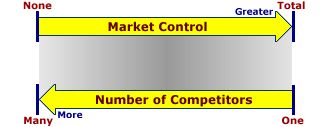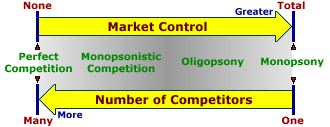
|
|
FOR WHOM?: One of three basic questions of allocation (What? and How? are the other two). Answering the "For Whom?" question of allocation determines who receives the goods that society produces with limited resources. Answering the "For Whom" question involves related questions such as, should goods be distributed to people according to incomes and ability to buy (contributive standard), wants and needs (needs standard), political affiliation, or some other criterion (perhaps equality standard)?
Visit the GLOSS*arama
|
|


|

|
                           MARKET STRUCTURE CONTINUUM: The four common market structures, perfect competition, monopoly, monopolistic competition, and oligopoly, can be viewed as a continuum based on (1) differences in the number of firms in a market, (2) the relative size of each firm, and thus (3) the market control of each firm. Perfect competition lies at one end and monopoly at the other. Monopolistic competition is close to perfect competition and oligopoly is near monopoly. The essence of the continuum is that monopolistic competition blends into oligopoly, with no clear-cut line of separation. Market structures form a continuum bounded by perfect competition on one end, monopoly on the other. Monopolistic competition and oligopoly then comprise the middle of the continuum. The continuum is based on the relative number and size of firms in the industry and the market control of each firm.At one end of the continuum, perfect competition has a large number of small firms with no market control. Moving along the continuum, monopolistic competition has a large number of small firms with some market control. Farther along, monopolistic competition blends into oligopoly, which has a small number of large firms with extensive market control. Reaching the other end, monopoly has a single firm with complete market control. A Continuum of Sellers| Market Structure Continuum |  |
The market structure continuum is illustrated by the exhibit to the right. The top of the continuum measures market control, increasing from none to total from left to right. The bottom of the continuum measures the number of competitors, increasing from one to many from right to left. Fewer competitors mean more market control and more competitors mean less market control.The position that each of the four basic market structures--perfect competition, monopolistic competition, oligopoly, and monopoly--occupy on the continuum can be identified easily with the click of a few buttons. - Perfect Competition: Click the [Perfect Competition] button to illustrate that perfect competition rests at the far left of the market structure continuum. It is characterized by a large number of relatively small competitors, each with no market control.
- Monopolistic Competition: Click the [Monopolistic Competition] button to see that monopolistic competition occupies much of the left portion of the market structure continuum, between perfect competition and the middle of the continuum. It is characterized by a large number of relatively small competitors, each with a modest degree of market control.
- Oligopoly: Next up is oligopoly, which occupies much of the right portion of the market structure continuum and can be highlighted with a click of the [Oligopoly] button. It is characterized by a small number of relatively large competitors, each with substantial market control.
- Monopoly: At the far right of the market structure continuum is monopoly, characterized by a single competitor and extensive market control. The position of this market structure can be revealed with a click of the [Monopoly] button.
As end points on this continuum, perfect competition and monopoly represent theoretical, ideal, extremes that do not exist in the real world in their purest forms. No markets in the real world, absolutely, totally, and completely match the characteristics of perfect competition. Some markets come close, but none match absolutely. Likewise, no markets in the real world, absolutely, totally, and completely match the characteristics of monopoly. Some markets come close, but none match absolutely. The real world is primarily populated by the two remaining market structures, monopolistic competition and oligopoly. With only a few exceptions, real world industries and markets are best represented by one of these two market structures. Shades of GrayPerhaps the most important is that the market structure continuum IS a continuum. Perfect competition, monopolistic competition, oligopoly, and monopoly are not four, totally distinct market structures. These market structures do not occupy four distinct points that make up the exhibit. One market structure blends into another. No clear-cut, crisp, well-defined dividing lines separate one market structure from another.In particular, some real world markets are best represented by monopolistic competition and others by oligopoly. However, other market structures have some characteristics of monopolistic competition, but also a few characteristics of oligopoly. Some monopolistically competitive markets are almost perfect competition. Some oligopolistic market structures are almost monopoly. The market structure continuum IS a continuum. The four basic market structures that make up the continuum are best thought of as guidelines or general categories. But variation and differences are the norm rather than the exception. A Continuum of Buyers| Market Structure Continuum |  |
While attention is generally focused on different market structures that arise due to market control among sellers, market control among buyers gives rise to a comparable market structure continuum.Such a buying-side continuum is illustrated in this exhibit. - Perfect Competition: At the far left of the continuum is perfect competition. As with the selling-side continuum, it is characterized by a large number of relatively small competitors, each with no market control.
- Monopsonistic Competition: Monopsonistic competition occupies much of the left portion of the market structure continuum, between perfect competition and the middle of the continuum. It is characterized by a large number of relatively small buyers, each with a modest degree of market control. It is the buying side counterpart to monopolistic competition.
- Oligopsony: Next up is oligopsony, which occupies much of the right portion of the market structure continuum between monopsony and the middle of the continuum. It is characterized by a small number of relatively large buyers, each with substantial market control. It is the buying side counterpart to oligopoly.
- Monopsony: At the far right of the market structure continuum is monopsony, characterized by a single buyer and extensive market control. It is the buying side counterpart to monopoly.
As with the selling-side market structure continuum, the continuum for the buying side IS a continuum with no clearly-cut lines of separation between the market structures.

Recommended Citation:MARKET STRUCTURE CONTINUUM, AmosWEB Encyclonomic WEB*pedia, http://www.AmosWEB.com, AmosWEB LLC, 2000-2025. [Accessed: July 18, 2025].
Check Out These Related Terms... | | | | | | | | | | | |
Or For A Little Background... | | | | | | | | | | | | | | |
And For Further Study... | | | | | | | | | | | | |
Search Again?
Back to the WEB*pedia
|



|

|
PURPLE SMARPHIN
[What's This?]
Today, you are likely to spend a great deal of time flipping through mail order catalogs trying to buy either a flower arrangement for your aunt or a birthday greeting card for your uncle. Be on the lookout for rusty deck screws.
Your Complete Scope
This isn't me! What am I?
|

|
|
Before 1933, the U.S. dime was legal as payment only in transactions of $10 or less.
|

|
|
"A winner is someone who recognizes his God-given talents, works his tail off to develop them into skills, and uses those skills to accomplish his goals. " -- Larry Bird, basketball player
|

|
IRPP
Institute for Research on Public Policy
|

|
|
Tell us what you think about AmosWEB. Like what you see? Have suggestions for improvements? Let us know. Click the User Feedback link.
User Feedback
|


|


